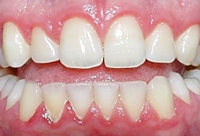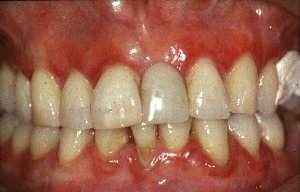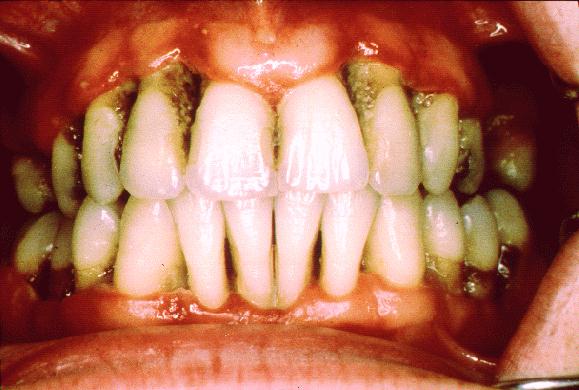
Gum disease is also known as periodontal disease. Periodontal means around a tooth. Any disease involving supporting tissues and bone around a tooth is called periodontal disease. There are 2 stages of gum disease, namely gingivitis and periodontitis. Gum disease can affect anyone including children.
Gum disease symptoms
Gingivitis is the initial stage of gum disease. It is characterized by mild swollen gum that bleeds during brushing and flossing. It is usually reversible with good oral hygiene regimes.
Periodontitis is the manifestation of uncontrolled gingivitis. It is characterized by
- severely  tender, swollen and bleeding gums
- bad breath
- tooth mobility
- presents of calculus (tartar) around the teeth
- deep pocketing (space between gum and root of tooth)
- pus formation due to infection of the gums
- teeth start to move away from its original position that causes spacing in between teeth
- loss of supporting bone levels
- receding gums
Gum disease causes
Gum disease is a result of poor oral hygiene. Plaque (colorless biofilm) sticks onto our teeth regularly as we eat and drink everyday. It will get mineralized and hardened into tartar if it is not brushed away from tooth surfaces. Plaque and tartar contain bacteria that will produce toxins to irritate surrounding gums causing swollen bleeding gums. If this condition is not dealt with, infection may proceeds into surrounding jaw bone causing them to resorb. Loss of supporting bone would cause looseness of tooth. There would be tenderness and difficulty in eating if the tooth is loose. Swollen gums may part away from tooth surfaces causing deep pocketing. These deep pockets may trap even more plaque and tartar that worsen the gum disease.
Prevalence
Gum disease is more prevalent with certain conditions, namely:
- Diabetes
- Taking steroids, anti-epileptic (seizure) medications, oral contraceptives, cancer therapy medications and calcium channel blockers
- Pregnant
- Mal-aligned teeth that causes plaque retention
- Tooth cavities that are not filled
- Failed crowns and bridges
- Poor fitting of dentures
- Immuno-suppressed patients ( AIDS)
- Tobacco smoking
- Betel nut chewing
Â
Gum disease treatment
To cure gum disease, you need to consult a dentist. For gingivitis, normal scaling is adequate to cure it. But you need to follow oral hygiene instructions given tightly to prevent it from recurring. Dentist would usually teach you the correct way of brushing and flossing.
For periodontitis, depending on the severity of the cases, after normal scaling, root planing is required to clean the tartar that sticks onto the root surfaces to allow the gums to heal well. This is often done under local anesthesia to prevent discomfort. Gum disease surgery is done if the dentist has to clean deeper part of roots which are not visible or reachable. A few visits is required if the gum disease is severe. A follow up of every 3 to 6 months is important to review the gum healing and bone settling. Sometimes, in severe cases, oral antibiotics are prescribed to aid in healing gum disease.
Ways to prevent gum disease
Practicing good oral hygiene regime is important. You need to know the correct way of brushing. You need to cover all three surfaces of tooth mainly the upper grinding surface, the front and the inner side. As for the side of each tooth, you need to floss to clean food debris that stuck in between teeth as normal brushes are unable to reach those areas. It is advisable to use fluoridated mouth rinses as adjunct to brushing. Mouth rinse has certain antiseptic effects which aid in healing infected gums. Some mouth rinse that contains chlorhexidine would stain teeth after a prolonged use so opt for other mouth rinse if it gives you staining.
Good oral hygiene is important to sustain good oral health. When gum disease occurs it takes a long time to heal so prevention is better than cure.



Pingback: How to Stop Toothache during Pregnancy | Intelligent Dental